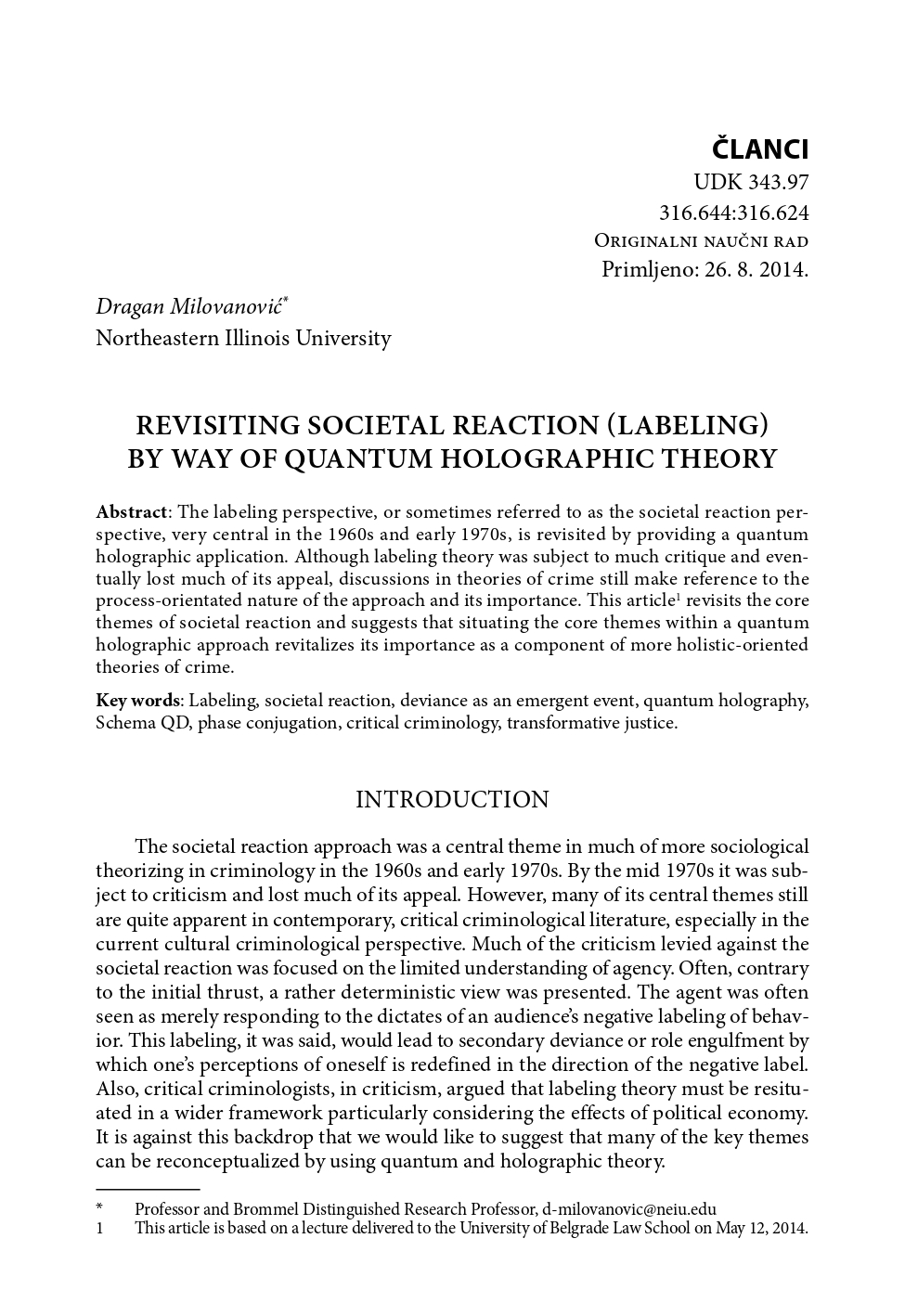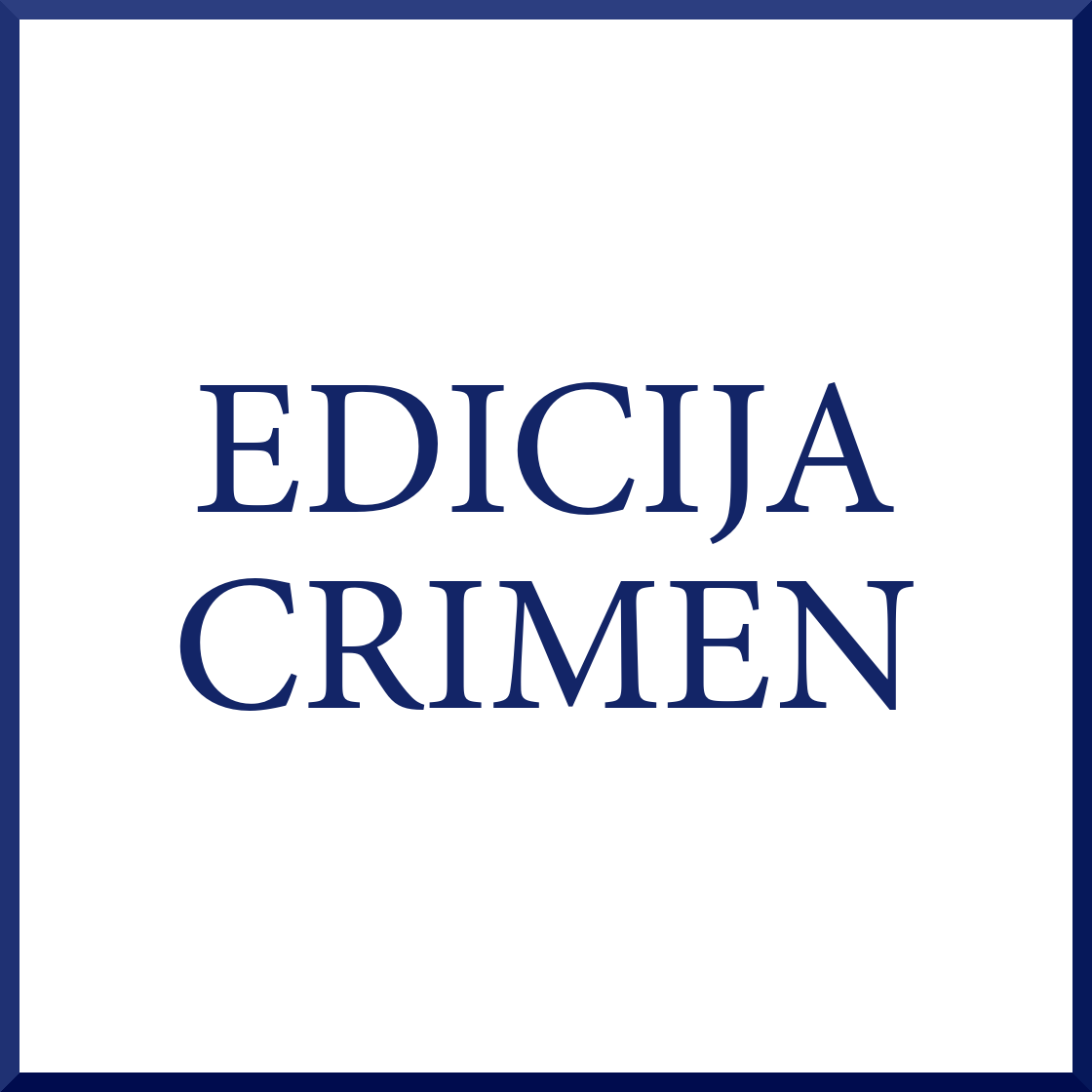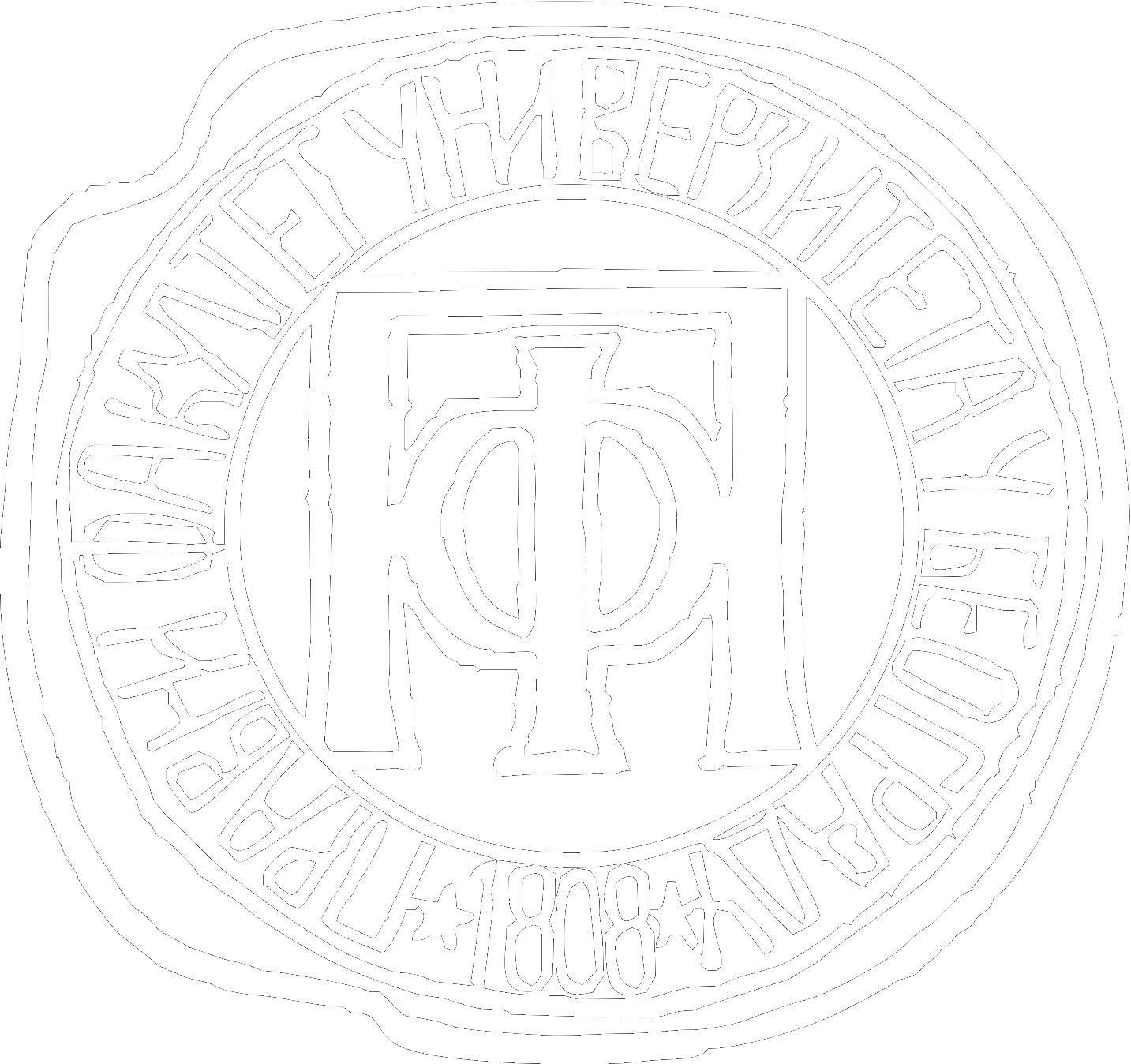Revisiting societal reaction (labeling) by way of quantum holographic theory
Keywords:
Labeling; societal reaction; deviance as an emergent event; quantum holography; Schema QD; phase conjugation; critical criminology; transformative justiceAbstract
The labeling perspective, or sometimes referred to as the societal reaction perspective, very central in the 1960s and early 1970s, is revisited by providing a quantum holographic application. Although labeling theory was subject to much critique and eventually lost much of its appeal, discussions in theories of crime still make reference to the process-orientated nature of the approach and its importance. This article1 revisits the core themes of societal reaction and suggests that situating the core themes within a quantum holographic approach revitalizes its importance as a component of more holistic-oriented theories of crime.
Downloads
References
Banks, C. 2008. Alaska Native Juveniles in Detention. Edwin Mellen Press.
Bergson, H. [1896] 2002. Matter and Memory. New York: Zone Books.
Bradley, R. 2010. "Detecting the Identity Signature of Secret Social Groups: Holographic Processes and the Communication of Member Affiliation." World Futures 66: 124–162. https://doi.org/10.1080/02604020903510265
Bradley, R. 2011. "Communication of Collective Identity in Secret Social Groups." Behavioral Sciences of Terrorism and Political Aggression 3 (3): 198–224. https://doi.org/10.1080/19434472.2010.512220
Busemeyer, J., and P. Bruza. 2012. Quantum Models of Cognition and Decision. Cambridge University Press. https://doi.org/10.1017/CBO9780511997716
Capek, M. 1971. Bergson and Modern Physics. New York: Humanities Press. https://doi.org/10.1007/978-94-010-3096-0
Cramer, J. 1986. "The Transactional Interpretation of Quantum Mechanics." Review of Modern Physics 58: 647–688. Available online: http://mist.npl.washington.edu/npl/int_rep/tiqm/TI_toc.html. https://doi.org/10.1103/RevModPhys.58.647
Cramer, J. 2006. "The Blind Men and the Quantum." http://www.niac.usra.edu/files/library/meetings/fellows/mar06/Cramer_John.pdf.
Emerson, J. 2007. Judging Delinquents. Aldine Transactions.
Ferrell, J., K. Hayward, and J. Young. 2008. Cultural Criminology. London: Sage.
Gabor, D. 1946. "Theory of Communication." Journal of the Institute of Electrical Engineers 93: 429–441. https://doi.org/10.1049/ji-3-2.1946.0074
Gibson, J. 1979. The Ecological Approach to Perception. Hillsdale, NJ: Lawrence Erlbaum.
Hartjen, C. 1974. Crime and Criminalization. New York: Praeger.
Henry, S., and M. Lanier, eds. 2001. What is Crime? Boulder, CO: Rowman and Littlefield.
Laszlo, E. 2007. Science and the Akashic Field. Rochester, VT: Inner Traditions.
Lacan, J. 1977. Écrits. New York: Norton.
Lemert, E. 2012. Social Pathology. Literary Licensing, LLC.
Levinas, E. 1998. Entre Nous: Thinking of the Other. New York: Columbia University Press.
Marcer, P., and W. Schempp. 1997. "Model of the Neuron Working by Quantum Holography." Informatica 21: 519–534.
Marcer, P., and W. Schempp. 1998. "The Brain as a Conscious System." International Journal of General Systems 27 (1): 231–248. https://doi.org/10.1080/03081079808962066
Matza, D. 1960. Delinquency and Drift. New York: Wiley.
Matza, D. 1969. Becoming Deviant. Englewood Cliffs, NJ: Prentice Hall.
Milovanovic, D. 2006. "Legalistic Definition of Crime and an Alternative View." The Annals of the Faculty of Law in Belgrade, International Edition, 78–86. Belgrade, Serbia.
Milovanovic, D. 2011. "Justice-Rendering Schemas: A Typology for Forms of Justice and a Prolegomenon for Transformative Justice." Journal of Theoretical and Philosophical Criminology 3 (1): 1–56.
Milovanovic, D. 2013a. "Quantum Holographic Critical Criminology." Journal of Theoretical and Philosophical Criminology 5 (2): 1–29.
Milovanovic, D. 2013b. "Postmodernism and Thinking Quantum Holographically." Special Issue, "Crucial Critical Criminology." Journal of Critical Criminology 21 (3): 341–357. https://doi.org/10.1007/s10612-013-9195-2
Milovanovic, D. 2014. Quantum Holographic Criminology: Paradigm Shift in Criminology, Law and Transformative Justice. Durham, NC: Carolina Academic Press.
Milovanovic, D., and S. Henry. 2001. "Constitutive Definition of Crime." In What is Crime?, edited by S. Henry and M. Lanier, 165–178. Boulder, CO: Rowman and Littlefield.
Mitchell, E., and R. Staretz. 2011. "The Quantum Hologram and the Nature of Consciousness." Journal of Cosmology 14: 1–19.
Patton, P. 2000. Deleuze and the Political. New York: Routledge.
Pribram, K. 1971. Languages of the Brain. Monterey, CA: Wadsworth. https://doi.org/10.1037/e400402009-003
Prigogine, I. 1981. From Being to Becoming: Time and Complexity in the Physical Sciences. San Francisco: W. H. Freeman.
Quinney, R. 1970. The Social Reality of Crime. Boston: Little, Brown and Company.
Robbins, S. 2006. "Bergson and the Holographic Theory of Mind." Phenomenological Cognitive Science 5: 365–395. https://doi.org/10.1007/s11097-006-9023-1
Robbins, S. 2012. Time and Memory. CreateSpace Independent Publishing Platform. https://www.createspace.com/.
Schur, E. 1972. Labeling Deviant Behavior. New York: Joanna Cotler Books.
Scheehan, D., ed. 2006. Frontiers of Time: Retrocausation—Experiment and Theory. Melville, NY: AIP Conference Proceedings, Vol. 863.
’t Hooft, G. 1993. "Dimensional Reduction in Quantum Gravity." arXiv preprint arXiv:gr-qc/9310026.
Susskind, L. 1995. "The World as a Hologram." Journal of Mathematical Physics 36. Preprint arXiv:hep-th/9409089. https://doi.org/10.1063/1.531249
Young, J. 2011. The Criminological Imagination. New York: Polity Press.

Downloads
Published
How to Cite
Issue
Section
License
Copyright (c) 2014 Dragan Milovanović

This work is licensed under a Creative Commons Attribution 4.0 International License.
The authors retain copyright and grant the journal the right of first publication, allowing others to share the work with proper attribution to the authors and acknowledgment of its original publication in this journal.










